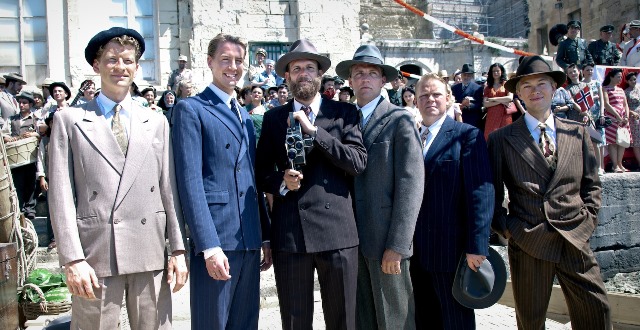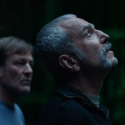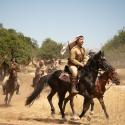Nothing proves a theory better than practice, and this is exactly what Norwegian adventurer-archaeologist-ethnographer Thor Heyerdahl did in 1947 when he and five companions sailed a raft from Peru to Polynesia to prove his hypothesis of how the Pacific islands were originally settled. He thought people first arrived there from the east, not the west, contravening the then-prevailing scientific orthodoxy. But Polynesians didn’t have boats, cried the establishment. Ah, but they had rafts, countered Heyerdahl. So he built one and launched it into an ocean whose currents it followed to Polynesia after 101 days at sea.
Kon-Tiki was what he named the raft, and Kon-Tiki the film is the story of his adventure. Although it's left unsaid, Heyerdahl’s ocean quest echoed his fellow Norsemen’s discovery of North America around 1000 AD but turned it on its head direction-wise. It took a modern-day Viking to show the sea as a highway, not a barrier. In real life – the film ignores this – Heyerdahl had posited that Polynesia was initially populated with the help of bearded, red-headed sea farers: actual Vikings.
 Heyerdahl’s extraordinary achievement caught the public imagination. The documentary film made of his journey won an Academy Award and his book sold tens of millions in many languages. Kon-Tiki was made to coincide with the 10th anniversary of his death in 2002 and is belatedly hitting British cinemas despite having been seen at the 2012 London Film Festival and being nominated for a Best Foreign Language Film Academy Award (pictured above, Pål Sverre Hagen's Thor Heyerdahl presents his ocean migration theory).
Heyerdahl’s extraordinary achievement caught the public imagination. The documentary film made of his journey won an Academy Award and his book sold tens of millions in many languages. Kon-Tiki was made to coincide with the 10th anniversary of his death in 2002 and is belatedly hitting British cinemas despite having been seen at the 2012 London Film Festival and being nominated for a Best Foreign Language Film Academy Award (pictured above, Pål Sverre Hagen's Thor Heyerdahl presents his ocean migration theory).
An international co-production, Kon-Tiki was Norway’s costliest film to date and became the country’s biggest-grossing film. Norwegian and English versions of the film were made side-by-side. Both are released in Britain, and exhibitors have the choice which to screen. Dialogue-wise, the Norwegian take moves slightly faster but there is little difference between them.
Although it's easy to understand why a film centring on a national hero would be so popular in Norway, filmmakers took surprisingly long to tackle such obvious subject matter. The voyage itself has been recreated but the raw material is the stuff of films in textbook form. Heyerdahl was a real-life, anti-establishment hero. He sacrificed his marriage pursuing his dream. He conquered a fierce ocean with no safety net. He and his fellow adventurers risked their lives. Action and drama: classic ingredients.
 Kon-Tiki sure-footedly racks up its tensions. After the raft is in the ocean, first there is a storm. Then, an initial encounter with a shark. Next up is friction between the sextet which is followed by structural problems with the failing raft. Finally, there is a fearsome reef to vanquish before landfall. With the story and the outcome so well known, creating drama was a challenge, yet the film’s episodic structure works and breath is taken in. Less successful is the depiction of Heyerdahl’s crumbling marriage with wife Liv. She remained in Norway and most of their interaction is by telephone. The domestic aspect feels bolted on. (pictured: the adventurous sextet in Peru before they take to the raft)
Kon-Tiki sure-footedly racks up its tensions. After the raft is in the ocean, first there is a storm. Then, an initial encounter with a shark. Next up is friction between the sextet which is followed by structural problems with the failing raft. Finally, there is a fearsome reef to vanquish before landfall. With the story and the outcome so well known, creating drama was a challenge, yet the film’s episodic structure works and breath is taken in. Less successful is the depiction of Heyerdahl’s crumbling marriage with wife Liv. She remained in Norway and most of their interaction is by telephone. The domestic aspect feels bolted on. (pictured: the adventurous sextet in Peru before they take to the raft)
The ocean – the film was mostly made around Malta – is stunningly captured and aerial panoramas are beautiful. A CGI school of whales is less impressive. Pål Sverre Hagen’s Heyerdahl is also not so convincing. He may have been an inspirational leader in real life, but this Heyerdahl is a somewhat bland cardboard cut-out. Early in the film, as a child, he is shown to be a risk taker and is also depicted as ambitious – he wants to be as well-known as Charles Darwin. But what drove him is hard to discern. It cannot have solely been self-aggrandisement.
Risks are taken by the film itself with its characterisation of Heyerdahl’s second-in-command Herman Watzinger. While everyone else is played with verisimilitude, Anders Baasmo Christiansen’s portrayal is bumbling, short and overweight – the opposite of the real Watzinger. This may not seem to matter too much, but Kon-Tiki seeks to celebrate a real-life adventure in a credible way yet undermines itself. Best approached as a taster for finding out more about the extraordinary Heyerdahl, Kon-Tiki is a fine adventure film but sticks to the surface and plays with facts. It could have been more.
Overleaf: watch the trailer for Kon-Tiki















Add comment